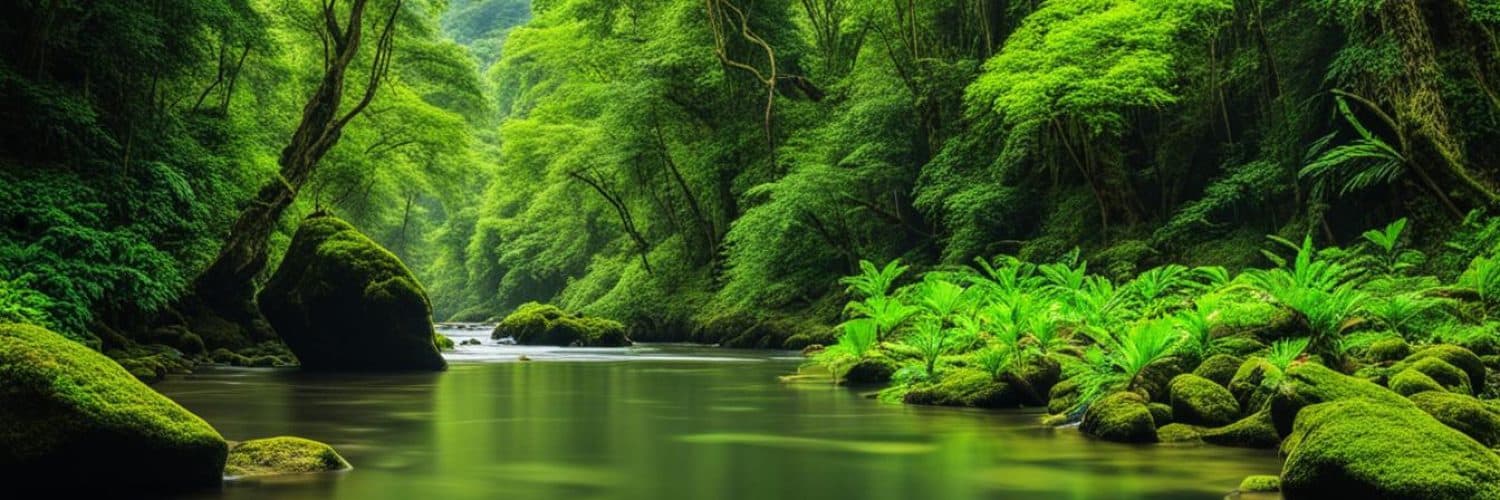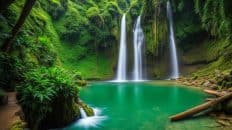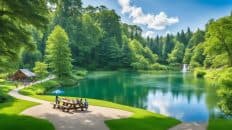Apayao Province, located in the Cordillera Administrative Region of the Philippines, is a hidden gem that offers breathtaking natural beauty and a wealth of cultural heritage. Nestled amidst lush forests, stunning caves, and pristine rivers, Apayao Province is a paradise for nature lovers and adventure enthusiasts.
With its diverse geography and rich cultural history, Apayao Province has something to offer for every traveler. Whether you’re seeking thrilling outdoor activities, exploring ancient caves, immersing in local culture, or indulging in delicious delicacies, Apayao has it all.
Key takeaways:
- Apayao Province is a landlocked province in the Cordillera Administrative Region of the Philippines.
- It is known for its untouched natural beauty, including lush forests, stunning caves, and pristine rivers.
- Apayao Province offers a wide range of outdoor activities and adventure opportunities.
- The province has a rich cultural heritage, with indigenous communities preserving their customs, beliefs, and traditional crafts.
- Apayao Province is also known for its delicious local delicacies.
Top 20 Apayao Tourist Spots
Apayao Province in the Philippines is a hidden gem with breathtaking natural beauty and a rich cultural heritage. Explore these top 20 Apayao tourist spots to experience the province’s enchanting attractions:
- Lussok Crystal Cave
- Apayao River
- Dupag Rock Formation
- Agora Wildlife Sanctuary
- Manacota Underground River
- Pudtol Church
- Apayao Eco-Tourism and Sports Complex
- Nagan River
- Mount Kilang
- Bayugao Falls
- Purag Cultural Village
- Calanasan Clay Pottery
- Apayao Provincial Museum
- Allacapan Butterfly Garden
- Apayao Ancestral House
- Mataguisi Church Ruins
- Apayao View Deck
- Marag Valley
- Bulala Lake
- Apayao Indigenous Games Festival
From the mystical underground rivers to the captivating cultural villages, these top Apayao attractions promise an unforgettable experience for tourists. Immerse yourself in nature’s wonders, discover the province’s historical treasures, and embrace the local traditions that make Apayao a truly remarkable destination.
Best Time to Visit Apayao
Apayao Province is a hidden gem in the Philippines, offering untouched natural beauty and a rich cultural heritage. If you’re planning a trip to Apayao, it’s important to consider the weather and choose the best time to visit. The dry season, from November to May, is the ideal time to explore this picturesque province.
During the dry season, Apayao experiences less rainfall, making it easier to participate in outdoor activities and enjoy sightseeing without interruptions. Whether you’re hiking through lush forests, exploring stunning caves, or discovering the province’s cultural heritage, the dry season offers more favorable conditions.
However, it’s always a good idea to check the weather forecast before you plan your trip. While the dry season generally offers pleasant weather, unexpected changes can occur. Staying informed about the latest weather updates will help you make the most of your visit to Apayao.
Embrace the best of Apayao during the dry season and immerse yourself in the province’s natural wonders and cultural treasures. Plan your visit between November and May to experience the beauty of this enchanting destination.
How to Get to Apayao
Apayao is a stunning province in the Cordillera Administrative Region of the Philippines, known for its untouched natural beauty and diverse attractions. If you’re planning a visit to this hidden gem, here are some tips on how to get to Apayao.
By Car
One option to reach Apayao is by car. If you’re coming from Metro Manila, you can take the North Luzon Expressway (NLEX) and continue on the Subic-Clark-Tarlac Expressway (SCTEX) until you reach the Tarlac-Pangasinan-La Union Expressway (TPLEX). From there, you can drive north towards Cagayan and follow the road to Apayao. The journey typically takes around 10-12 hours, depending on traffic conditions.
By Public Transportation
For those who prefer public transportation, buses are available from Manila to various towns in Apayao. The most common destination is Kabugao, the provincial capital. Several bus companies offer trips to Apayao, and the journey usually takes around 10-12 hours.
Additionally, there are connecting roads that link Apayao to other provinces such as Kalinga, Cagayan, and Ilocos Norte. This makes it convenient for travelers to explore multiple destinations in the region.
Once you arrive in Apayao, you can easily navigate the province through local transportation options such as tricycles or jeepneys.
Travel Tips
- Before embarking on your journey, it’s advisable to check the road conditions and weather forecast.
- Pack comfortable clothing and essentials for your trip, especially if you’ll be engaging in outdoor activities.
- Consider hiring a local guide to ensure a smooth and enriching experience in Apayao.
Whether you choose to drive or take public transportation, getting to Apayao is an adventure in itself. Enjoy the scenic landscapes along the way and get ready to immerse yourself in the untouched natural beauty of this captivating province.
Accommodation Options in Apayao
When planning your visit to Apayao, you’ll find a range of accommodation options to suit your needs and budget. Whether you prefer budget-friendly hostels or comfortable hotels and guesthouses, Apayao has something for everyone. The towns of Kabugao and Luna are particularly popular choices for tourists, offering a variety of places to stay.
Here are some recommended accommodation options in Apayao:
- Kabugao: Known for its accessibility to the province’s top tourist spots, Kabugao offers a selection of hotels and guesthouses that cater to different preferences. From cozy family-run guesthouses to modern hotel establishments, you’ll find a comfortable place to rest after a day of exploring Apayao’s natural wonders.
- Luna: Situated near the stunning Dupag Rock Formation and Apayao River, Luna is another great choice for accommodation. You’ll find a range of options, including budget-friendly hotels and guesthouses that provide basic amenities for a pleasant stay.
Plan your stay in Apayao and make a reservation in advance to secure your preferred accommodation. Whether you’re looking for a budget-friendly option or a more comfortable stay, Apayao has the perfect accommodation to enhance your travel experience.
Local Delicacies in Apayao
Apayao is a province in the Philippines that offers more than just breathtaking natural beauty. It is also known for its mouthwatering local delicacies that reflect the rich culinary heritage of the region. When visiting Apayao, make sure to indulge in these traditional flavors:
Etag
Etag is a local delicacy in Apayao made from smoked pork. The meat is marinated with a special mixture of spices and then hung to dry and smoke for several days. The result is a savory and flavorful cured meat that is perfect for pairing with rice or as an ingredient in various dishes.
Pinikpikan
Pinikpikan is a traditional dish in Apayao that involves the unique process of beating a live chicken with sticks before cooking. This practice tenderizes the meat and imparts a distinct flavor. The chicken is then grilled to perfection, resulting in a delicious and juicy dish with a smoky aroma.
Kini-ing
Kini-ing is another popular dish in Apayao, particularly among the Isnag/Itneg community. It is made by smoking various types of meat, such as pork, beef, or carabao meat. The smoked meat is thinly sliced and can be enjoyed as a snack or used as an ingredient in different recipes.
Binatog
Binatog is a classic rice delicacy in Apayao. It is made from boiled white corn kernels that are mixed with grated coconut and salt. The mixture is then topped with margarine or butter and sprinkled with sugar. Binatog is a popular street food in the province, best enjoyed warm on a chilly evening.
Exploring the local delicacies of Apayao is not only a gastronomic experience but also an opportunity to immerse yourself in the rich cultural heritage of the province. Don’t miss the chance to savor these authentic flavors and discover the culinary treasures Apayao has to offer.
Biodiversity and Conservation Efforts in Apayao
Apayao is blessed with a remarkable biodiversity, showcasing a wide array of flora and fauna that contribute to the province’s ecological significance. The serene landscapes and untouched forests of Apayao create an ideal habitat for various species, making it a haven for nature enthusiasts and researchers alike.
To protect and preserve its natural treasures, Apayao has established several protected areas. These sanctuaries serve as crucial habitats for wildlife and contribute to the overall conservation efforts in the province. Two notable protected areas in Apayao are:
- Calanasan Wildlife Sanctuary: Spanning over 100,000 hectares, the Calanasan Wildlife Sanctuary is home to endangered species such as the Philippine pangolin, Philippine Eagle, and Philippine Brown Deer. The sanctuary also hosts numerous plant species, showcasing the province’s rich plant biodiversity.
- Apayao Protected Landscape and Seascape: Encompassing both terrestrial and marine ecosystems, the Apayao Protected Landscape and Seascape covers an area of approximately 506,304 hectares. This protected area safeguards critical habitats like forests, rivers, waterfalls, and coral reefs, providing refuge for various species.
The conservation efforts in Apayao extend beyond protected areas, aiming to promote sustainable practices and ensure the long-term preservation of the province’s natural resources. These efforts include:
- Wildlife Preservation: Apayao implements measures to protect endangered species and promote biodiversity conservation. These initiatives include monitoring populations, conducting research, and raising awareness about the importance of wildlife preservation.
- Forest Restoration: Recognizing the vital role of forests in maintaining ecological balance, Apayao focuses on reforestation efforts. Tree-planting activities, forest fire prevention, and sustainable logging practices contribute to the restoration and sustainable management of forest resources.
- Community Involvement: The conservation efforts in Apayao emphasize the engagement and participation of local communities. Collaborative projects, capacity-building initiatives, and sustainable livelihood programs empower communities to become stewards of the environment, fostering a culture of conservation.
Apayao’s commitment to biodiversity conservation and sustainable practices ensures the preservation of its natural heritage for future generations. Through the protection of its rich ecosystems and active community involvement, Apayao maintains its status as a sanctuary for diverse flora and fauna.
Cultural Heritage in Apayao
Apayao Province in the Philippines is not only known for its stunning natural beauty but also for its rich cultural heritage. The province is home to several indigenous communities who have preserved their customs, beliefs, and traditional crafts over generations.
Apayao is a melting pot of diverse indigenous cultures, including the Isnag/Itneg, Kalinga, Ibanag, Gaddang, Malaweg, and Dumagat communities. Each community has its distinct practices and traditions, contributing to the vibrant tapestry of Apayao’s culture.
Traditional Crafts and Artistry
Indigenous communities in Apayao are known for their remarkable craftsmanship and traditional arts. These communities excel in various traditional crafts such as:
- Weaving: The art of weaving is deeply ingrained in Apayao’s indigenous culture. Skilled artisans create intricate and vibrant textiles, using techniques passed down through generations. These woven fabrics are often used for clothing, accessories, and home decor.
- Tattooing: Tattooing holds great cultural significance in Apayao. Indigenous communities practice traditional tattooing as a form of self-expression and identity. Each tattoo design represents specific meanings and serves as a visual narrative of their rich history.
- Pottery: Pottery-making is another traditional craft that thrives in Apayao. Artisans mold clay into beautiful and functional pottery, showcasing the creativity and ingenuity of the indigenous communities.
- Music: Apayao’s indigenous communities have a deep connection with music. They have their unique musical instruments, such as the gangsa (bronze gongs), bamboos, and other percussion instruments. Traditional music plays a significant role in ceremonies, celebrations, and social gatherings.
These traditional crafts not only showcase the exceptional skills of the artisans but also reflect the cultural identity and values of the indigenous communities in Apayao.
A Glimpse into Apayao’s Indigenous Culture
“The rich cultural heritage of Apayao’s indigenous communities is a treasure trove waiting to be discovered. From their vibrant festivals and rituals to their unique traditional crafts, exploring the indigenous culture of Apayao is a truly enriching experience.”
Visitors to Apayao can immerse themselves in the local culture by participating in traditional festivals and events that highlight the customs and traditions of the indigenous communities. These cultural celebrations are an opportunity to witness captivating dances, vibrant costumes, and heartfelt rituals.
Additionally, tourists can interact with the indigenous artisans, learning about their craftsmanship and even try their hand at traditional arts under the guidance of these skilled masters.
Preserving and Honoring the Cultural Heritage
Efforts are underway to preserve and promote Apayao’s cultural heritage. The local government, along with community leaders and organizations, work together to safeguard the traditions and skills of the indigenous communities.
Through cultural preservation programs, workshops, and exhibitions, Apayao aims to raise awareness about the importance of preserving indigenous culture and ensuring its continuity for future generations.
| Indigenous Community | Traditional Craft |
|---|---|
| Isnag/Itneg | Weaving |
| Kalinga | Tattooing |
| Ibanag | Pottery |
| Gaddang | Music |
| Malaweg | Weaving |
| Dumagat | Tattooing |
By supporting the indigenous communities and their traditional crafts, visitors can contribute to the sustainable development of Apayao while preserving its cultural heritage.
Conclusion
Apayao Province in the Philippines is a hidden gem that offers an abundance of natural beauty, cultural heritage, and unforgettable experiences for travelers. Whether you’re exploring the stunning caves and rivers or immersing yourself in the rich local culture, visiting Apayao guarantees a memorable adventure.
Apayao’s untouched landscapes and pristine wilderness make it a paradise for nature enthusiasts and adventure seekers. From the crystal-clear waters of Apayao River to the breathtaking rock formations of Dupag, the province showcases the raw beauty of its surroundings.
But Apayao is not just about its natural wonders. The province’s cultural heritage is deeply rooted in its indigenous communities, who have preserved their customs, beliefs, and traditional crafts. Immerse yourself in the vibrant cultures of the Isnag/Itneg, Kalinga, Ibanag, Gaddang, Malaweg, and Dumagat communities and witness their traditional weaving, tattooing, pottery, and music.
So, if you’re seeking a unique and authentic travel experience, plan your visit to Apayao Province. Explore the untouched natural beauty, engage with the local communities, and create memories that will last a lifetime. Apayao is waiting to be discovered, so embark on your journey to Cordillera’s Last Nature Frontier today.
FAQ
What are the top tourist spots in Apayao Province?
The top tourist spots in Apayao Province include Lussok Crystal Cave, Apayao River, Dupag Rock Formation, Agora Wildlife Sanctuary, Manacota Underground River, Pudtol Church, Apayao Eco-Tourism and Sports Complex, Nagan River, Mount Kilang, Bayugao Falls, Purag Cultural Village, Calanasan Clay Pottery, Apayao Provincial Museum, Allacapan Butterfly Garden, Apayao Ancestral House, Mataguisi Church Ruins, Apayao View Deck, Marag Valley, Bulala Lake, and Apayao Indigenous Games Festival.
When is the best time to visit Apayao?
The best time to visit Apayao is during the dry season, which is from November to May. The weather is more favorable for outdoor activities and sightseeing during this period.
How can I get to Apayao?
You can get to Apayao by car or public transportation from Metro Manila. Buses ply the route from Manila to various towns in Apayao, with Kabugao being the most common destination. There are also connecting roads to other provinces such as Kalinga, Cagayan, and Ilocos Norte.
What are the accommodation options in Apayao?
What are the local delicacies in Apayao?
Some must-try local delicacies in Apayao include “etag” (smoked pork), “pinikpikan” (grilled chicken), “kini-ing” (smoked meat), and rice delicacies such as binatog.
What is the biodiversity like in Apayao, and what conservation efforts are in place?
Apayao is home to a rich biodiversity with diverse flora and fauna. The province has several protected areas, including the Calanasan Wildlife Sanctuary and Apayao Protected Landscape and Seascape. Conservation efforts focus on wildlife preservation, forest restoration, and community involvement.
What is the cultural heritage in Apayao like?
Apayao Province is known for its cultural heritage, with indigenous communities such as the Isnag/Itneg, Kalinga, Ibanag, Gaddang, Malaweg, and Dumagat. These communities have preserved their customs, beliefs, and traditional crafts such as weaving, tattooing, pottery, and music.
What can I expect during my visit to Apayao?
During your visit to Apayao, you can expect to discover untouched natural beauty, experience outdoor activities and adventure, immerse in the local culture and heritage, and indulge in delicious local delicacies.


















Add comment